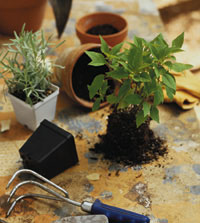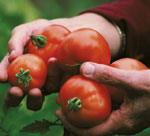Getting started
by Alicia Lundquist Guy
This article was originally published in March 2004

(March 2004) — Early spring always finds me in great anticipation. The bulbs are blooming and the sun is shining with a little more warmth; but where are the baskets full of local strawberries and peaches? Alas, a few months away. Farmers are busy out in the field tending the seedlings that will become sweet carrots, and the delicate flowers soon to be crimson cherries. So, for a while, we must continue to look to southern climes for our sustenance.
But wait! What are these dew-dappled gems that beckon at the entrance to our stores? Plant starts from some of our favorite local growers have arrived in full force. If you don’t meet the requirements to grow plants from seeds (supplemental light and heat, a sunny yard, an absence of inquisitive pets and, of course, time), starts offer the perfect opportunity to participate in the advent of spring and become our own farmers, if only in a terra cotta pot.
It’s inherently rewarding to watch a vine of snow peas grow until that early summer day when you can snap off a crunchy snow pea and savor it right there in the middle of the garden. Call me boring, but growing plants is great entertainment!
Several local producers are on hand to provide us with such early season entertainment, and you’ll find their plant starts in your local PCC. Rent’s Due Ranch in Stanwood offers a wide variety of organically grown vegetable and herb starts including lettuce, spinach, crucifers and the best snow peas you’ll ever eat.
For a less practical fancy, you can pick up some petite violas or pansies. Cascade Cuts in Bellingham brings in a variety of culinary herbs including mint, sage and lavender. You’re also apt to find some alpine strawberries that often come back a year later in our mild climate.
Treat yourself to a little gardening gift next time you do your grocery shopping. Instead of a latté, I pick up small plants to get my morning off to a good start. (Plus, if I buy just a few at a time, I don’t have a big “project” when I get home.) You’ll have so much fun that, before you know it, those baskets of peaches will be here.

Tomato tips
by David Johnson, Horticulturist
Surprisingly, tomatoes do not need full sunshine to thrive. What tomatoes really need are warm night temperatures. Our days often get warm enough, but tomatoes originate in a climate that stays pretty warm in the evening as well. Here in the Northwest, we get about two weeks of such weather in mid-July as a rule. The optimal temperature range for tomatoes is 74 to 84 degrees.
When selecting young tomato plants, buy them in the four-packs early on and keep them inside until the soil temperature reaches 60 degrees. Avoid buying large plants that are in bloom or have that purplish look caused by chilling injury. Ideally, the young plants should have a bright green color. The latest date to start plants at home from seed would be about mid-March.
Sandy soil
Create a raised bed of very sandy soil medium (at least 50 percent sand). Bring the pH up to about 6.5 with Dolomite lime (see advisory on lime, “The scoop on organic fertilizer,” Sound Consumer, March 2003). Add some very coarse gravelly sand to the surface; it allows the plants to sprawl and the fruit will remain dry.
Do not crowd
This is important! Do not crowd tomatoes. Crowding the plants will create cooler, damper conditions and encourage the development of blight sooner in the fall season. Tomatoes tend to be quite rampant. Spacing should be no closer than 36 inches apart.
